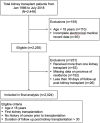Incidence of De Novo Post-Transplant Malignancies in Thai Adult Kidney Transplant Recipients: A Single-Center, Population-Controlled, Retrospective Cohort Study at the Highest Volume Kidney Transplant Center in Thailand
- PMID: 38468637
- PMCID: PMC10926888
- DOI: 10.3389/ti.2024.11614
Incidence of De Novo Post-Transplant Malignancies in Thai Adult Kidney Transplant Recipients: A Single-Center, Population-Controlled, Retrospective Cohort Study at the Highest Volume Kidney Transplant Center in Thailand
Abstract
Kidney transplant recipients (KTRs) are at increased risk of developing de novo post-transplant malignancies (PTMs), with regional differences in types with excess risk compared to the general population. A single-center, population-controlled, retrospective cohort study was conducted at a tertiary care center in Thailand among all adults who underwent their first kidney transplant from 1986 to 2018. Standardized incidence ratios (SIRs) of malignancy by age, sex, and place of residence were obtained using data from the National Cancer Registry of Thailand as population control. There were 2,024 KTRs [mean age, 42.4 years (SD 11.4); female patients, 38.6%] during 16,495 person-years at risk. Of these, 125 patients (6.2%) developed 133 de novo PTMs. The SIR for all PTMs was 3.85 (95% CI 3.22, 4.56), and for pooled solid and hematologic PTMs, it was 3.32 (95% CI 2.73, 3.99). Urothelial malignancies had the largest excess risk, especially in women [female SIR 114.7 (95% CI 66.8, 183.6); male SIR 17.5 (95% CI 8.72, 31.2)]. The next two most common cancers were non-Hodgkin's lymphoma and skin cancer [SIR 20.3 (95% CI 13.6, 29.1) and 24.7 (95% CI 15.3-37.8), respectively]. Future studies are needed to identify the risk factors and assess the need for systematic screening among PTMs with excess risk in KTRs.
Keywords: Thailand; adult; cancer; incidence; kidney transplantation.
Copyright © 2024 Srisuwarn, Sutharattanapong, Disthabanchong, Kantachuvesiri, Kitiyakara, Phakdeekitcharoen, Ingsathit and Sumethkul.
Conflict of interest statement
The authors declare that the research was conducted in the absence of any commercial or financial relationships that could be construed as a potential conflict of interest.
Figures
Similar articles
-
Sex and gender as predictors for allograft and patient-relevant outcomes after kidney transplantation.Cochrane Database Syst Rev. 2024 Dec 19;12(12):CD014966. doi: 10.1002/14651858.CD014966.pub2. Cochrane Database Syst Rev. 2024. PMID: 39698949
-
Interventions for BK virus infection in kidney transplant recipients.Cochrane Database Syst Rev. 2024 Oct 9;10(10):CD013344. doi: 10.1002/14651858.CD013344.pub2. Cochrane Database Syst Rev. 2024. PMID: 39382091
-
Delayed initiation or reduced initial dose of calcineurin-inhibitors for kidney transplant recipients at high risk of delayed graft function.Cochrane Database Syst Rev. 2025 Apr 8;4(4):CD014855. doi: 10.1002/14651858.CD014855.pub2. Cochrane Database Syst Rev. 2025. PMID: 40197799
-
Serum and urine nucleic acid screening tests for BK polyomavirus-associated nephropathy in kidney and kidney-pancreas transplant recipients.Cochrane Database Syst Rev. 2024 Nov 28;11(11):CD014839. doi: 10.1002/14651858.CD014839.pub2. Cochrane Database Syst Rev. 2024. PMID: 39606952
-
Comparison of Two Modern Survival Prediction Tools, SORG-MLA and METSSS, in Patients With Symptomatic Long-bone Metastases Who Underwent Local Treatment With Surgery Followed by Radiotherapy and With Radiotherapy Alone.Clin Orthop Relat Res. 2024 Dec 1;482(12):2193-2208. doi: 10.1097/CORR.0000000000003185. Epub 2024 Jul 23. Clin Orthop Relat Res. 2024. PMID: 39051924
Cited by
-
Spectrum of cancer risk in Asian American and Pacific Islander solid organ transplant recipients.J Natl Cancer Inst. 2025 Jul 1;117(7):1456-1464. doi: 10.1093/jnci/djaf069. J Natl Cancer Inst. 2025. PMID: 40112042 Free PMC article.
-
De novo colorectal cancer after kidney transplantation: a systematic review and meta-analysis.Br J Cancer. 2025 Jun;132(11):1010-1018. doi: 10.1038/s41416-025-02994-7. Epub 2025 Apr 5. Br J Cancer. 2025. PMID: 40188290
-
The Burden of Genitourinary Malignancies in Southeast Asia from 1990 to 2021.Eur Urol Oncol. 2025 May 30:S2588-9311(25)00132-4. doi: 10.1016/j.euo.2025.05.008. Online ahead of print. Eur Urol Oncol. 2025. PMID: 40450435
-
Post-Kidney Transplant Cancer: A Real-World Retrospective Analysis From a Single Italian Center.Transpl Int. 2024 Aug 20;37:13220. doi: 10.3389/ti.2024.13220. eCollection 2024. Transpl Int. 2024. PMID: 39228659 Free PMC article.
References
MeSH terms
LinkOut - more resources
Full Text Sources
Medical
Miscellaneous



